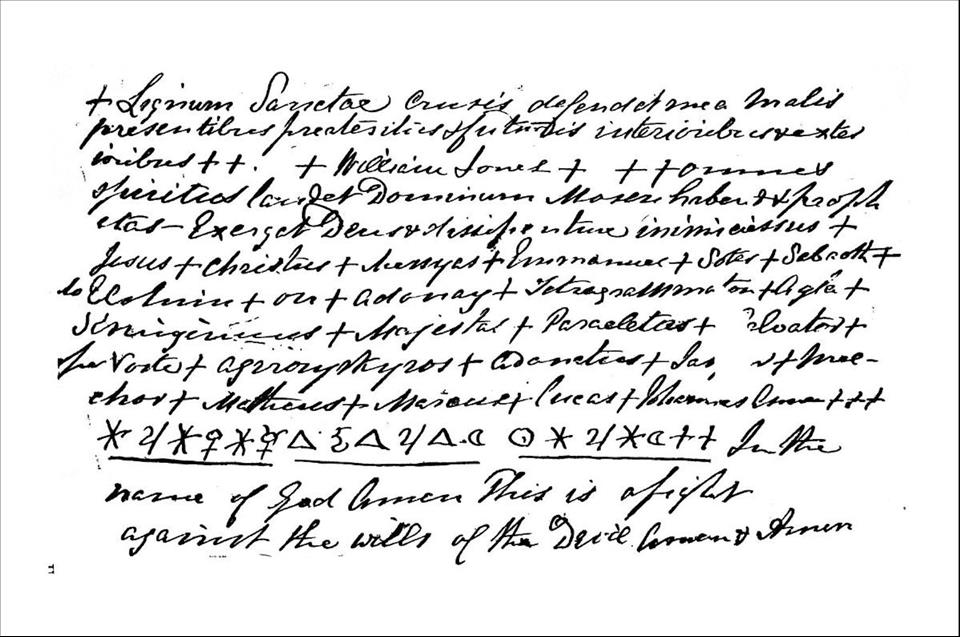
Warding Off Witchcraft With Paper: An Everyday Solution For Everyday Problems
In the early 20th century, a variety of objects were used to keep witchcraft and evil at bay, such as horseshoes, bent nails , shoes and boots, and mummified animals . One such objects was paper, which had been used as a charm since at least the early medieval period – particular words written on paper were meant to carry power to ward off witches and defeat evil.
Evil and witchcraft were not seen in terms of sensational or supernatural events. Common problems like illness, sick and dying livestock, the butter not churning properly, or family members becoming involved with unsuitable people could all be attributed to the work of witchcraft.
In many areas of England and Wales, if people experienced a run of misfortune, as well as (or instead of) consulting a doctor or vet they might go to visit the“cunning man” (dyn hysbys in Welsh), who would diagnose their problem. There are some surviving accounts of what would happen when a client went to consult a dyn hysbys.
The dyn hysbys would first engage the client in conversation to establish the nature of the problem that was causing concern and would then withdraw to another room to consult their books. This would usually be a collection of almanacks, astrological charts and magic texts, such as The Key of Solomon – a magic text from the Renaissance period which was widely available in printed form at the time.
Mr Evan Griffiths, a dyn hysbys from Llangurig, mid-Wales, 1928. National Museum of Wales 2024 , CC BY-NC
The dyn hysbys would then return and tell the client that their problem was caused by a witch having placed a curse on them, or by someone who wanted their land or property ill-wishing them. Sometimes the solution would be to write them a charm on a small piece of paper for protection. The charm would often be sealed in a bottle or handed over folded with strict instructions that it would not be read. These charms could then be hidden away in the barn with the animals, if it was for their protection, or in the home. The standard rate for a written charm was said to be five shillings (about 25p today) around 1918.
Written charms have existed for centuries to ward off evil and bad luck. The ones written around 1840 and 1939 in the mid-Wales areas of Powys, Ceredigion and Meirionnydd had a distinctive style to those found in other parts of the British Isles and Europe. These are slips of paper with closely written lines of text, in English and Latin, from the Christian tradition or astrological symbols. The texts often call on God, Jesus, the Holy Ghost, archangels and other heavenly powers to relieve the person named in the charm from“witchcraft, evil men and women, and hardness of heart.”
We are fortunate that over 30 of these charms are known to survive in collections and there are probably many more in private ownership. In these charms, the dyn hysbys frequently included the name of the client (and sometimes where they were from), and the problem which the charm was intended to solve. This allows us to see who went to the dyn hysbys and why – and tells us some interesting stories.
For example, one farmer from Ceredigion regularly appeared in Welsh newspapers as winning prizes with his livestock at agricultural shows between 1870 and 1900. When one of his prize Welsh Black cows was taken ill, he visited the dyn hysbys and a charm to protect“his cow that is bad” was written out for him.
In the mid-1920s, a miller from Meirionnydd visited the well-known dyn hysbys Evan Griffiths of Llangurig, to try to stop his sister's relationship with an unsuitable man. Griffiths wrote a charm“to stop her speak to that X, put a stop to it at once”. On this occasion, the charm did not work as the couple were married in 1927.
Where today we might consult Google when faced with everyday problems, less than a century ago we might have put more faith in a charm written on paper.
Looking for something good? Cut through the noise with a carefully curated selection of the latest releases, live events and exhibitions, straight to your inbox every fortnight, on Fridays. Sign up here .

Legal Disclaimer:
MENAFN provides the
information “as is” without warranty of any kind. We do not accept
any responsibility or liability for the accuracy, content, images,
videos, licenses, completeness, legality, or reliability of the information
contained in this article. If you have any complaints or copyright
issues related to this article, kindly contact the provider above.
Most popular stories
Market Research

- CEA Industries ($BNC) Announces BNB Holdings Of 480,000 Tokens, And Total Crypto And Cash Holdings Of $663 Million
- Whale.Io Launches Battlepass Season 3, Featuring $77,000 In Crypto Casino Rewards
- Kucoin Appeals FINTRAC Decision, Reaffirms Commitment To Compliance
- Daytrading Publishes New Study Showing 70% Of Viral Finance Tiktoks Are Misleading
- Bitmex Launches Uptober Carnival Featuring A $1,000,000 Prize Pool
- PU Prime Launches Halloween Giveaway: Iphones, Watches & Cash Await




















Comments
No comment